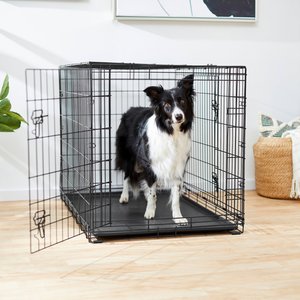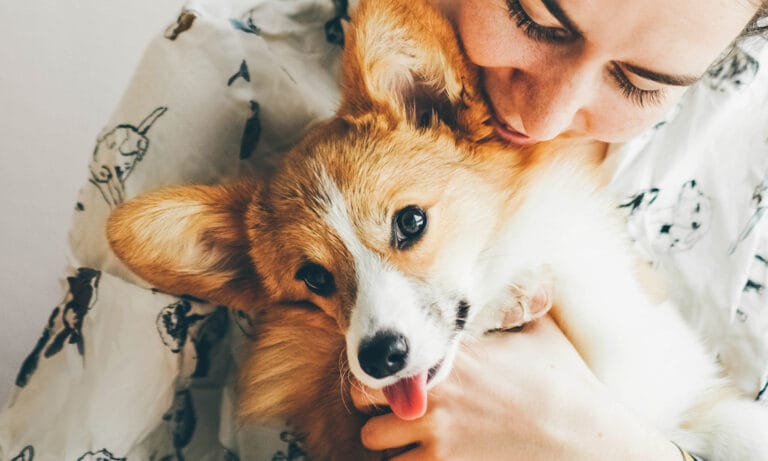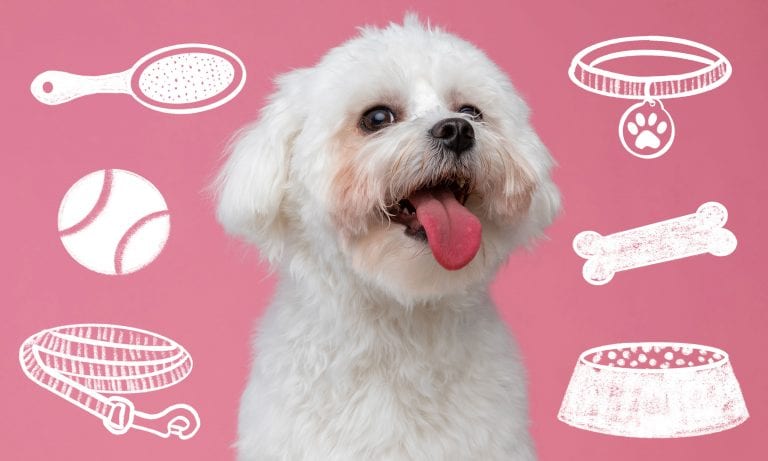The first 21 weeks of a dog’s life play a huge rule in his personality and behavior down the road. So now is your chance to raise the dog you’ve always wanted. Experts spill the beans on what new pet parents are mostly likely to do wrong, and deliver some helpful dog training techniques, puppy potty training tips and more to get you off to a happy and healthy start with your bundle of joy.
Ruff Spot: You give your puppy too much freedom.
Master Class: “Puppies don’t handle freedom well,” says Camilla Gray-Nelson, author of Lipstick and the Leash: Dog Training A Woman’s Way. “In their natural environment, there are always other dogs looking over their shoulder, telling the puppy where to go and what not to do.” To mimic this behavior, you have to establish boundaries from day one. Gray-Nelson suggests not letting your puppy leave the room you’re in because he doesn’t have self-control or the ability to self-direct. You also might not want to allow your puppy to jump on the sofa (or you) uninvited. “It’s cute when a puppy is 8 pounds, but when he reaches 80 pounds, you probably wouldn’t want him doing the same thing,” she says.
Ruff Spot: You don’t pay close attention to your puppy’s potty signs.
Master Class: Everyone seems to have puppy potty training tips. But the truth is, some breeds are simply easier to potty train than others. “Some dogs, especially larger breeds, are practically born housebroken, and if given the choice, they won’t defile their quarters,” says Gray-Nelson. “You basically just have to show them to the door.” For the tougher-to-train dogs, she says, you need to limit the amount of space in the house that they have access to and watch for signs that he needs to go. “If you witness an attempt to start to go inside, make a loud noise—which they will begin to have a negative association with—and rush them outside,” she says. Dog potty pads like those from Frisco can be helpful. When you’re not home for a few hours, you can give your puppy a defined boundary area like a garage or kitchen where he can move around and do his business on a potty pad,” says Gray-Nelson.
Ruff Spot: You don’t expose your puppy to enough people and things.
Master Class: Here’s one of the most important dog training techniques: “Puppies need at least three walks a day and should meet at least 100 people by week 10,” says dog behaviorist Drayton Michaels, founder of Urban Dawgs in Red Bank, New Jersey. Make sure the people are of all ages, shapes, sizes and skin colors. “If your puppy only sees your family for the 12 weeks, he is going to think all humans only look like you and be fearful or even aggressive with other people,” says canine behaviorist Beverly Ulbrich, owner of the Pooch Coach in San Francisco. You also need to expose your puppy to common outdoor items. “Issue food rewards when your puppy notices ‘weird things,’ like bikes, strollers and traffic,” says Michaels. “This way the dog makes a positive association, and it helps place trust in their long-term memory.”
Ruff Spot: You don’t let your puppy play with older, bigger dogs.
Master Class: Not exposing your puppy to more mature dogs will hinder their development. “Ideally, call a couple of your friends who have well-behaved, friendly dogs and see if you can get together for a puppy playdate. In this situation, you have more control over puppy play so it stays positive,” says Gray-Nelson. However, don’t rule out a dog park. “Puppies need to learn how to play, and at a dog park, older dogs might give them soft corrections if they’re doing something wrong,” says Ulbich. “If you wait until your dog is 7 or 8 months old to bring him to a dog park, he won’t get the benefit of those soft corrections because the other dogs will think he should know better by now. It’s like a 2-year-old walking up and hugging a stranger versus a 21-year-old doing it.”
Ruff Spot: You don’t have a plan for leaving the puppy at home alone.
Master Class: Learn about dog crate training a puppy. Buy an easy-to-fold crate that’s big enough for your puppy to stand and turn around, but not to walk around. Put a non-spillable dish with food and water inside, and line the dog crate with a blanket and a few toys. You want to make crate training a puppy a positive experience for him. Start with increments of 10 minutes during the day and work your way up to longer amounts of time—so you leave your puppy in the crate if you need to run out to the store for an hour or so. “It’s also helpful to keep your puppy crated at night and teach him to sleep there,” says Ulrich. “You might have to let him cry it out the first night or two.” Most puppies should be able to sleep through the night without a potty break by the time they’re four months old, according to the American Kennel Club.
Ruff Spot: You often call your puppy with an angry or exasperated tone of voice.
Master Class: “You want your dog to stop a bad behavior because of your instructions, not fear,” says Michaels. “That will put him at a higher risk of aggression and biting.” Instead, connect with the word “come” with something wonderful like a treat, says Gray-Nelson.
Ruff Spot: You don’t put your puppy on a leash.
Master Class: Leash training a puppy is crucial. “Get a leash on your puppy as soon as possible,” says Ulrich, “even if you’re just having him wear it in the house and guiding him from room to room.” If you wait a couple of months to leash train a puppy, he’s much more likely to balk at wearing one.
Share:











